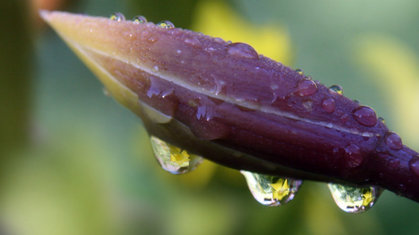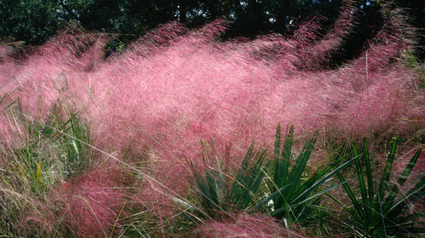Gulf Muhly photo: Desktoppictures.com
The Beauty of Grasses
by Chris Winslow
I believe a leaf of grass is no less than the journey-work of the stars
- Walt Whitman
For some reason gardeners often overlook our ornamental grasses.
Grass is for mowing, people say… and when visiting a nursery you
normally want to buy a tree, vegetables, a perennial, or something
that will yield flowers. Not just a clump of grass.
But as you drive around Travis and Hays counties, keep your eyes
open and observe how creative landscape designers – and home gar-
deners – are using grasses as soft boundaries, or planting them in big
groups, or using them as a screen.
The good news about these grasses is that they are versatile, easy
to grow, and provide beautiful fall and winter color for the garden.
They are also remarkably adaptable to different sun conditions and
once established they can survive a drought. Gardeners really don’t
have to do much to make them flourish.
Outside of a few spring flowering grasses, most produce their showy
seed heads in the fall and add foliage color throughout the winter.
Our only garden chores are to water infrequently during extended
drought and to cut back the winter foliage when new growth begins
to show in the spring. Here are some of my favorite choices for
central Texas landscapes:
____________________________________________________
The Mulenbergias
This native genus has many grasses that are showy, easy to grow,
and easy to find in local nurseries:
Coastal muhley grass (Mulenbergia capillaries), also known as
“Gulf” muhley, grows to a height and width of 3 feet. Its gray-green
foliage produces pink, mist-like, seed heads in the fall, that are
striking, especially when backlit by the sun. (in stock, 1 gal: $7.99)
Big muhley (Mulenbergia lendheimeri) produces feathery tan col-
ored seed heads in the fall on top of foliage that is bluish green.
Big muhley grows to a height and width of four feet. It grows
throughout the Hill Country and is extremely hardy. Deer, cows,
horses, goats, and sheep won’t eat it.(1 gal. $7.99)
Bamboo muhley (Mulenbergia dumosa) is the largest of the muhley
grasses, growing over four feet with bamboo-like feathery foliage
which turns the color of straw in the winter months. It should be
cut back in the spring when new growth appears. Unlike spread-
ing bamboo, it isn’t invasive. It stands alone as a beautiful specimen.
(3 gal. for 19 99)
____________________________________________________
The Maidengrasses
In the genus Miscanthus, there are 15 varieties of hardy ornamental
grasses that can be used for accent, borders, and screens. All have
pretty seed heads in the fall and winter, and should be cut back in
the spring. A few varieties to look for are standard and dwarf maiden-
grass, adagio, cabaret, morning light, and porcupine or zebra grass.
____________________________________________________
The Fountain Grasses
In the genus Pennisetum, these also show many forms and colors.
They range in size from the dwarf fountain grass that grows under
two feet to the standard fountain grasses that get to five feet or taller.
One of the most outstanding of the fountain grasses is rubrum or
purple fountain grass. It can grow to five feet and has reddish-purple
foliage with purple seed heads. Rubrum needs to be cut back after
the first freeze and mulched well. (1 gal. for $7.99)
Its winter hardiness is not as good as the other grasses. In contrast
to purple fountain grass is a variety called ‘moudry’ which has
black seed heads and grows under two feet.
The ornamental grasses can give color throughout the year, are easy
to grow, adaptable to varying light conditions, deer resistant, and
very drought tolerant. They are a great choice for our water stressed
conditions. Happy Gardening everyone!





